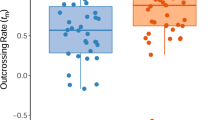Abstract
Homomorphic self-incompatibility (SI) evolved in many plant families to enforce selfing avoidance, and is controlled by a single multiallelic locus (the S-locus). In a fragmented landscape, strong variation in population size and in local density is expected to cause strong variation in allelic diversity at the S-locus, which could generate an Allee effect on female reproductive success by constraining compatible pollen availability. In this experimental study, we aimed at detecting this SI-specific Allee effect (or S-Allee effect) in the endangered species Biscutella neustriaca. We demonstrated the occurrence of a SI mating system in the species and determined compatibility relationships among genotypes through a large set of controlled pollinations. For the experiment, we chose three different pollen receptor genotypes, each compatible with respectively 100, 75 and 25% of four other genotypes, which constituted the pollen sources. We placed different ramets of each receptor at different distances from the pollen sources to control for pollen limitation due to low local density, and we measured the seed set on each receptor plant three times consecutively. Analyses performed with generalized linear mixed models showed that both the distance to the pollen sources and the mate availability due to SI had a significant effect on seed set, with a strong reduction observed when mate availability was limited to 25%. Our results suggest that pollen limitation due to a restriction in compatible mate availability could occur in small or scattered populations exhibiting low allelic diversity at the S-locus.




Similar content being viewed by others
References
Ågren J (1996) Population size, pollinator limitation and seed set in the self-incompatible herb Lythrum salicaria. Ecology 77:1779–1790
Antonovics J, Levin DA (1980) The ecological and genetic consequences of density-dependent regulation in plants. Ann Rev Ecol Sys 11:411–452
Ashman TL, Knight TM, Steets JA, Amarasekare P, Burd M, Campbell DR, Dudash MR, Johnston MO, Mazer SJ, Mitchell RJ, Morgan MT, Wilson WG (2004) Pollen limitation of plant reproduction: ecological and evolutionary causes and consequences. Ecology 85:2408–2421
Bates D, Maechler M (2009) lme4: linear mixed-effects models using S4 classes. R package version 0.999375-31
Barrett SCH, Husband BC (1997) Ecology and genetics of ephemeral plant populations: Eichhornia paniculata (Pontederiaceae) in Northeast Brazil. J Hered 88:277–284
Billiard S, Castric V, Vekemans X (2007) A general model to explore complex dominance patterns in plant sporophytic self-incompatibility systems. Genetics 175:1351–1369
Brys R, Jacquemyn H, Beeckman T (2008) Morph-ratio variation, population size and female reproductive success in distylous Pulmonaria officinalis (Boraginaceae). J Evol Biol 21:1281–1289
Brys R, Jacquemyn H, De Bruyn L, Hermy M (2007) Pollination success and reproductive output in experimental populations of the self-incompatible Primula vulgaris. Int J Plant Sci 168:571–578
Busch JW, Schoen JD (2008) The evolution of self-incompatibility when mates are limiting. Trends Plant Sci 13:128–136
Byers DL, Meagher TR (1992) Mate availability in small populations of plant species with homomorphic sporophytic self-incompatibility. Heredity 68:353–359
Campbell LG, Husband BC (2007) Small populations are mate-poor but pollinator-rich in a rare, self-incompatible plant, Hymenoxys herbacea (Asteraceae). New Phytol 174:915–925
Cartwright RA (2009) Antagonism between local dispersal and self-incompatibility systems in a continuous plant population. Mol Ecol 18:2327–2336
Castric V, Vekemans X (2004) Plant self-incompatibility in natural populations: a critical assessment of recent theoretical and empirical advances. Mol Ecol 13:2873–2889
DeMauro MM (1993) Relationship of breeding system to rarity in the lakeside daisy (Hymenoxys acaulis var. glabra). Conserv Biol 7:542–550
Eckert CG, Manicacci D, Barrett SCH (1996) Genetic drift and founder effect in native versus introduced populations of an invading plant, Lythrum salicaria (Lythraceae). Evolution 50:1512–1519
Elam DR, Ridley CE, Goodell K, Ellstrand NC (2007) Population size and relatedness affect fitness of a self-incompatible invasive plant. P Natl Acad Sci USA 104:549–552
Fischer M, Hock M, Paschke M (2003) Low genetic variation reduces cross-compatibility and offspring fitness in populations of a narrow endemic plant with a self-incompatibility system. Conserv Genet 4:325–336
Gascoigne J, Berec L, Gregory S, Courchamp F (2009) Dangerously few liaisons: a review of mate-finding Allee effects. Popul Ecol 51:355–372
Glémin S, Bataillon T, Ronfort J, Mignot A, Olivieri I (2001) Inbreeding depression in small populations of self-incompatible plants. Genetics 159:1217–1229
Glémin S, Petit C, Maurice S, Mignot A (2008) Consequences of low mate availability in the rare self-incompatible species Brassica insularis. Conserv Biol 22:216–221
Holderegger R, Häner R, Csencsics D, Angelone S, Hoebee S (2008) S-allele diversity suggests no mate limitation in small populations of a self-incompatible plant. Evolution 62:2922–2928
Igic B, Lande R, Kohn JR (2008) Loss of self-incompatibility and its evolutionary consequences. Int J Plant Sci 169:93–104
Kirchner F, Luijten SH, Imbert E, Riba M, Mayol M, Gonzalez-Martýnez SC, Mignot A, Colas B (2005) Effects of local density on insect visitation and fertilization success in the narrow-endemic Centaurea corymbosa (Asteraceae). Oikos 111:130–142
Knight TM, Steets JA, Vamosi JC, Mazer SJ, Burd M, Campbell DR, Dudash MR, Johnston MO, Mitchell RJ, Ashman T-L (2005) Pollen limitation of plant reproduction: pattern and process. Annu Rev Ecol Evol S 36:467–497
Larson BMH, Barrett SCH (2000) A comparative analysis of pollen limitation in flowering plants. Biol J Linn Soc 69:503–520
Lawrence MJ (2000) Population genetics of the homomorphic self-incompatibility polymorphisms in flowering plants. Ann Bot 85:221–226
Levin DA, Kelley C, Sarkar S (2009) Enhancement of Allee effects in plants due to self-incompatibility alleles. J Ecol 97:518–527
Llaurens V, Billiard S, Leducq JB, Castric V, Klein EK, Vekemans X (2008) Does frequency-dependent selection with complex dominance interactions accurately predict allelic frequencies at the self-incompatibility locus in Arabidopsis halleri? Evolution 62:2545–2557
Marshall TC, Slate J, Kruuk L, Pemberton JM (1998) Statistical confidence for likelihood-based paternity inference in natural populations. Mol Ecol 7:639–655
Ockendon DJ (1975) Dominance relationships between S-alleles in the stigma of Brussels sprouts (Brassica oleraceae var. gemmifera). Euphytica 24:165–172
Pickup M, Young AG (2008) Population size, self-incompatibility and genetic rescue in diploid and tetraploid races of Rutidosis leptorrhynchoides (Asteraceae). Heredity 100:268–274
Prigoda NL, Nassuth A, Mable BK (2005) Phenotypic and genotypic expression of self-incompatibility haplotypes in Arabidopsis lyrata suggests unique origin of alleles in different dominance classes. Mol Biol Evol 22:1609–1620
Reinartz JA, Les DH (1994) Bottleneck-induced dissolution of self-incompatibility and breeding system consequences in Aster Furcatus (Asteraceae). Am J Bot 81:446–455
R Development Core Team (2009) R: a language and environment for statistical computing. R Foundation for Statistical Computing, Vienna, Austria
Schierup MH, Vekemans X, Christiansen FB (1997) Evolutionary dynamics of sporophytic self-incompatibility alleles in plants. Genetics 147:835–846
Takayama S, Isogai A (2005) Self-incompatibility in plants. Annu Rev Plant Biol 56:467–489
Vekemans X, Schierup MH, Christiansen FB (1998) Mate availability and fecundity selection in multi-allelic self-incompatibility systems in plants. Evolution 52:19–29
Wagenius S, Lonsdorf E, Neuhauser C (2007) Patch aging and the S-Allee effect: breeding system effects on the demographic response of plants to habitat fragmentation. Am Nat 169:383–397
Waites AR, Ågren J (2004) Pollinator visitation, stigmatic pollen loads, and among-population variation in seed set in Lythrum salicaria. J Ecol 92:512–526
Willi Y, Van Buskirk J, Fischer M (2005) A threefold Allee effect: population size affects cross-compatibility, inbreeding depression, and drift load in the self-incompatible Ranunculus repens. Genetics 169:2255–2265
Wright S (1939) The distribution of self-sterility alleles in populations. Genetics 24:538–552
Yokoyama S, Hetherington LE (1982) The expected number of self-incompatibility alleles in finite plant populations. Heredity 48:299–303
Zuur AF, Ieno EN, Walker NJ, Saveliev AA, Smith GM (2009) Mixed effects models and extensions in ecology with R. Springer, New York
Acknowledgements
We give special thanks to colleagues: Yves Piquot and Nina Hautekèete for introducing B. neustriaca as a model species, Pierre Saumitou-Laprade for the protocol for microsatellite development and scoring, Cecile Godé for the microsatellite-enriched bank, Eric Schmitt for plant care in the greenhouse, Nathalie Faure and Sophie Vauquier for their contributions to the cross-pollinations, and Bart Goemaere for logistic help. We thank the staff at the Conservatoire des Sites Naturels de Haute-Normandie, and Bertille Valentin and Christophe Blondel from the Conservatoire Botanique National de Bailleul, for providing plants and the experimental field. We also thank the participants to the Congen ESF-funded meeting on plant reproductive systems in conservation genetics (Lille, October 2008) for their useful comments on the results presented here. This work was co-supported and co-funded by the Université des Sciences et Technologies de Lille and the European Union through the Life Programme “Rescue of Viola hispida and Biscutella neustriaca on the Seine Valley”. Finally, we thank the two anonymous reviewers for their numerous comments to improve the manuscript.
Author information
Authors and Affiliations
Corresponding author
Electronic supplementary material
Below is the link to the electronic supplementary material.
Rights and permissions
About this article
Cite this article
Leducq, JB., Gosset, C.C., Poiret, M. et al. An experimental study of the S-Allee effect in the self-incompatible plant Biscutella neustriaca . Conserv Genet 11, 497–508 (2010). https://doi.org/10.1007/s10592-010-0055-2
Received:
Accepted:
Published:
Issue Date:
DOI: https://doi.org/10.1007/s10592-010-0055-2




